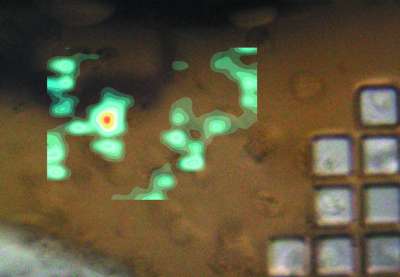Doing more with less; in cellulo structure determinations

As a counter to this time-consuming and substantial scientific effort, there are a number of examples of protein crystallization events occurring in vivo, with next to no human input. In a case presented in a recent paper an insect virus exploits the phenomenon as part of its life cycle.
Not surprisingly an issue with intracellular protein crystals is that they are typically very small, limited by the size of the cell. However, microfocus beamlines at synchrotron light sources prove here to be capable and refined in the analysis of micron-scale in vivo samples.
A group of scientists from the Diamond Light Source and the University of Oxford, UK [Axford et al. (2014), Acta Cryst. D70, 1435-1441; doi:10.1107/S1399004714004714] has been able to study crystals inside the cells directly using X-ray analysis without complex attempts to extract and prepare samples.
It would not be out of place to assume that the presence of cellular material might compromise the experiment. However, the researchers’ results show that the exact opposite may actually be true; the cell maintains the crystals in an environment amenable to the collection of data.
It will be interesting to see if an improved understanding of protein crystallization in vivo can bring more targets within reach of such analysis.
Certainly continued technical developments, including increased photon flux and reduced beam size, will improve the signal-to-noise ratio.
Together with more efficient data processing, this means that we will be able to do more with less and exploit novel microcrystal targets of increasing complexity for in vivo structural studies.
Jonathan Agbenyega
Business Development Manager, IUCr
Media Contact
All latest news from the category: Physics and Astronomy
This area deals with the fundamental laws and building blocks of nature and how they interact, the properties and the behavior of matter, and research into space and time and their structures.
innovations-report provides in-depth reports and articles on subjects such as astrophysics, laser technologies, nuclear, quantum, particle and solid-state physics, nanotechnologies, planetary research and findings (Mars, Venus) and developments related to the Hubble Telescope.
Newest articles

Novel genetic plant regeneration approach
…without the application of phytohormones. Researchers develop a novel plant regeneration approach by modulating the expression of genes that control plant cell differentiation. For ages now, plants have been the…

Roadmap to close the carbon cycle
A holistic approach to reach net-zero carbon emissions across the economy. A major approach to achieving net-zero carbon emissions relies on converting various parts of the economy, such as personal…

Cost-effective, high-capacity, and cyclable lithium-ion battery cathodes
Charge-recharge cycling of lithium-superrich iron oxide, a cost-effective and high-capacity cathode for new-generation lithium-ion batteries, can be greatly improved by doping with readily available mineral elements. The energy capacity and…





















